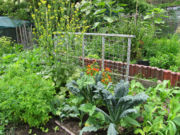Difference between revisions of "Food/Permaculture"
| Line 14: | Line 14: | ||
A surprising trend that has emerged in recent years is urban gardening: city dwellers are starting to grow food on balconies, rooftops, roadsides, parks and any little patch of bare soil they can find. Urban gardens may be part of the food puzzle in the future (and, moreover, they serve a social and recreational function) but it will require controlled-environment agriculture for cities to produce all the food they need. | A surprising trend that has emerged in recent years is urban gardening: city dwellers are starting to grow food on balconies, rooftops, roadsides, parks and any little patch of bare soil they can find. Urban gardens may be part of the food puzzle in the future (and, moreover, they serve a social and recreational function) but it will require controlled-environment agriculture for cities to produce all the food they need. | ||
| + | |||
| + | Permaculture uses such techniques as soil cultivation, plant-animal symbiosis, agroforestry, water harvesting, no-till farming and integrated pest management to create a productive system in which all agricultural processes are taken care of by the dynamic interaction of the parts of the system. This reduces labour considerably, as there is no need to till fields, spray crops or irrigate. Once soil fertility has built up to a certain level, it becomes unnecessary to spread fertilizer. In theory, a productive ecosystem, once established, can run without human labour. In practice some labour is generally needed, though one system of permaculture, the Fukuoka Method, claims that no human labour is necessary. | ||
While not as automated nor as productive as the aeroponics techniques described to the left, permaculture is a highly practical and advanced methodology that can play a role in making Spaceship Earth work for everybody. In time, it may become possible to automate permaculture by using sensors to detect when plants are ready for harvest, and having robots that can pick vegetables, prune trees and so forth. | While not as automated nor as productive as the aeroponics techniques described to the left, permaculture is a highly practical and advanced methodology that can play a role in making Spaceship Earth work for everybody. In time, it may become possible to automate permaculture by using sensors to detect when plants are ready for harvest, and having robots that can pick vegetables, prune trees and so forth. | ||
Revision as of 16:30, 24 July 2010
Most of the food produced nowadays in the industrialized world comes from large centralized farms that focus on a small number of crops or animals. These agricultural systems require a constant input of fertilizer, pesticide, water and other resources, and have a constant output of pesticide-contaminated runoff water and other waste.
By contrast, permaculture creates an interconnected system of flora and fauna that recycles its own resources. It is an multi-species ecosystem rather than a factory-style production outfit.
On a permaculture farm, different organisms work in synergy. The output of one part of the system becomes the input of another; animal waste becomes plant food. There is (theoretically at least) no waste, allowing the system to be 'permanent', able to go on for millenia without adversely affecting the local ecosystem.
Industrial-style farming techniques deplete 6-24 kilos of soil for ever kilo of food grown [1]. This is a perfect example of a failure to think long-term; growing food in a way that diminishes the land's capacity to grow food is like killing the goose that lays the golden eggs. Permaculture (as its name suggests), focuses on the long-term fertility of the soil. Permaculture can create 20 kilos of newly fertile soil for every kilo of food grown[2].
Permaculture is not only an ecologically sound means of food-production, it is very efficient. Permaculture expert David Blume makes a convincing case for the efficiency of permaculture, writing, "In a good but somewhat sloppy design, you need about 500 square feet (46.5m2) per person maximum. In a very good design, 200 square feet (18.5m2) will do the job." John Jeavons (father of another school of permaculture called biointensive agriculture), makes more conservative claims of around 316-372 square meters [3] [4].
It is worth noting that climbing plants, like grapes and beans, require essentially no ground space to grow.
A surprising trend that has emerged in recent years is urban gardening: city dwellers are starting to grow food on balconies, rooftops, roadsides, parks and any little patch of bare soil they can find. Urban gardens may be part of the food puzzle in the future (and, moreover, they serve a social and recreational function) but it will require controlled-environment agriculture for cities to produce all the food they need.
Permaculture uses such techniques as soil cultivation, plant-animal symbiosis, agroforestry, water harvesting, no-till farming and integrated pest management to create a productive system in which all agricultural processes are taken care of by the dynamic interaction of the parts of the system. This reduces labour considerably, as there is no need to till fields, spray crops or irrigate. Once soil fertility has built up to a certain level, it becomes unnecessary to spread fertilizer. In theory, a productive ecosystem, once established, can run without human labour. In practice some labour is generally needed, though one system of permaculture, the Fukuoka Method, claims that no human labour is necessary.
While not as automated nor as productive as the aeroponics techniques described to the left, permaculture is a highly practical and advanced methodology that can play a role in making Spaceship Earth work for everybody. In time, it may become possible to automate permaculture by using sensors to detect when plants are ready for harvest, and having robots that can pick vegetables, prune trees and so forth.
